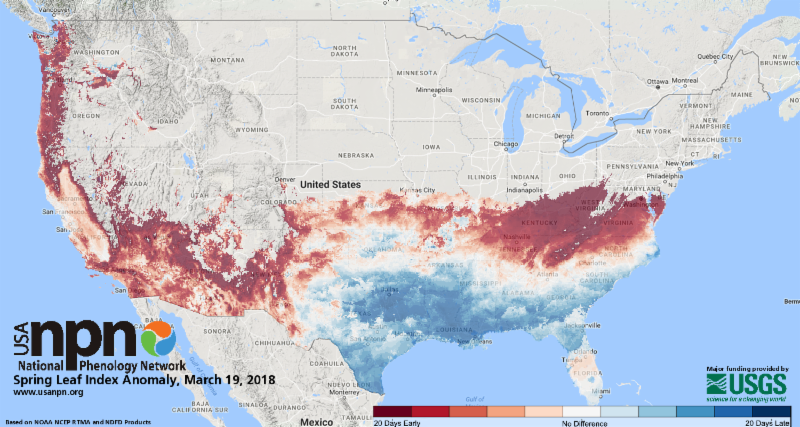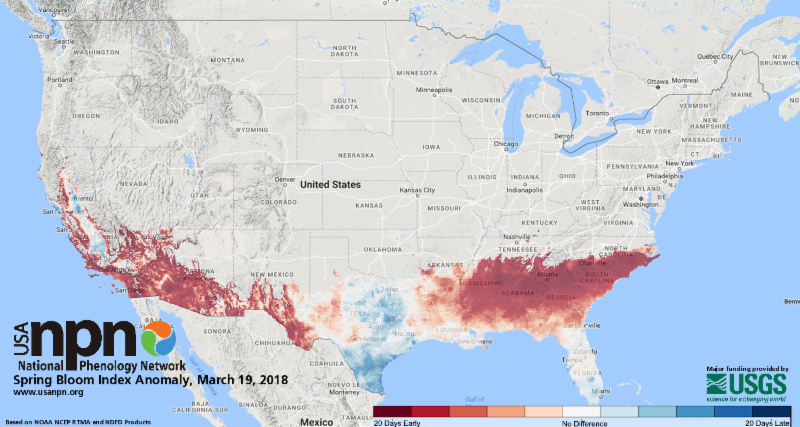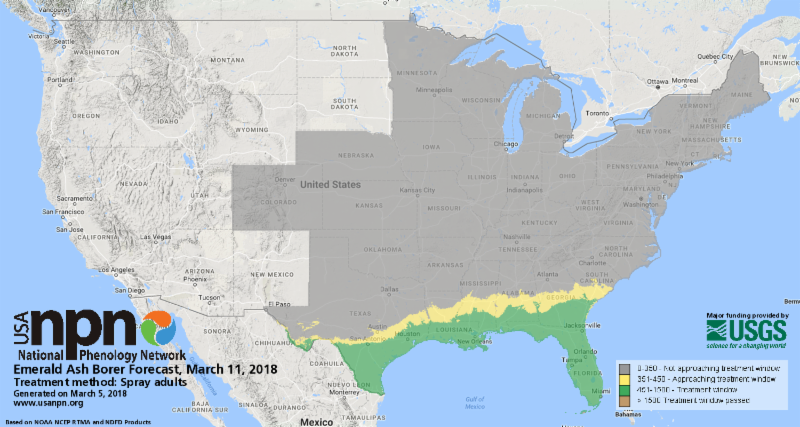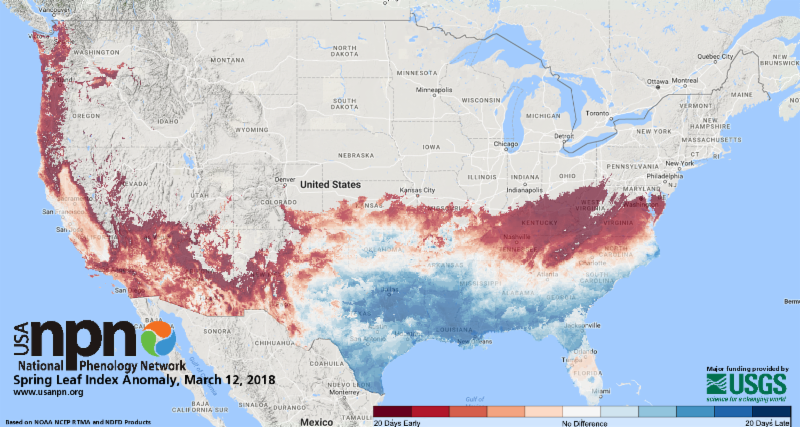|
 
According to the calendar, today is the first day of spring! But the plants and animals around us tell the real story. Whether you're in New England awaiting the next Nor'easter or in the west hoping for a little more rain, our
status of spring maps predict whether spring has actually arrived at your location, and whether it is early or late this year.
Our First Leaf Index predicts the leaf out of plants that are among the first to show their leaves in the spring (think lilacs and other early season shrubs). The map on the
top right
shows spring leaf out across
the country so far this year.
The colors represent the difference between this year and a 30-year average. Red colors indicate this year is ahead of normal; blue indicates this year is behind normal for a particular location. Spring leaf out arrived early in the west and mid-Atlantic, but late in much of the Southeast.
The First Bloom Index represents
blooming of lilacs and other shrubs as well as
leaf out of deciduous trees. The map on the lower right shows that the Bloom Index, which predicts phenology activity at a later point in the spring, tells a different story than the Leaf index. Aside from parts of Texas, the spring bloom has arrived early across the country so far this year, including in the Southeast.
How will spring shape up across the remainder of the country, and how will this year's spring impact plant and animal phenology? Only time will tell!
Sincerely,
 |
and |
|
|
|
|
What's new at Nature's Notebook and USA-NPN
|
|

Pheno Forecasts predict pest activity near you
Our new
Pheno Forecast maps show when management actions should be taken for five pest species including emerald ash borer, apple maggot, lilac bor
er, hemlock woolly adelgid, and winter moth. These maps are updated daily and are available 6 days in the future.
|
How does calendar spring stack up to nature?
Today marks the Spring Equinox, the first day of astronomical spring. However, it doesn't often match up to plant and animal activity on the ground. We compared the Spring Equinox to the USA-NPN's First Leaf Index for our nation's capital to see how calendar spring stacks up to nature. The majority of years have seen spring leaf out occur days to weeks earlier than calendar "spring".
|

Is spring leaf out early in your area?
Spring leaf out continues to arrive early in the West, Southwest, and mid-Atlantic, compared to a long-term average (1981-2010). Spring leaf out arrived one week early in Salt Lake City, UT, and two weeks early in Boise, ID. Parts of Nevada and eastern Washington, Oregon, and California are 4-5 weeks early.
|
 |
|
 |
Julio Betancourt and Mark Schwartz, USA-NPN co-founders
|
Celebrating 10 years of USA-NPN and NN
This year marks the 10th anniversary of the USA National Phenology Network and the 10th year of data collection in
Nature's Notebook!
We are celebrating with monthly highlights on different aspects of our program. This month, we feature USA-NPN co-founders
Dr. Julio Betancourt of the US Geological Survey and Dist. Prof. Mark D. Schwartz of the University of Wisconsin-Milwaukee
.
|
|
|
Recent happenings in the field of phenology
|
Linking time-lapse images to observations
To better link phenology data from time-lapse cameras and on-the-ground observations, authors of a new study in Ecosphere compared digital images of tree foliage color from spring to autumn to observations made using the USA-NPN protocols. The authors also found that chill and minimum temperature in autumn, drought stress in autumn, and heat stress in summer are all important factors to the timing of peak fall foliage color.
|
Long term springcasting
USA-NPN collaborators Drs. Toby Ault and Carlos Carrillo at Cornell University recently released a
new tool
to forecast spring. The team uses long-term weather forecasts to predict when spring will arrive a whole season in advance.
maps, which use real-time weather data to show short-term forecasts,
spring's actual arrival date, and how the arrival compares to normal.
|
 |
|
 |
Hermit Warbler
Photo: Tom Grey
|
Spring birdsong shifting earlier
Authors of a new study in The Condor: Ornithology Applications studied the timing of song and other vocal activity in birds in Northern California. They found that Neotropical migrants may be less flexible than residents in adapting their phenology to changes in climate. The method of survey, which involved automated sound recorders, has potential to track shifts in elevation, population, and changes in breeding behaviors for many bird species.
|
|
More ways to get involved
|
|
Celebrate National Citizen Science Day
April 14th is National Citizen Science Day! This year will mark the third year of this major celebration. Find out about events planned across the country, or learn how to plan your own event.
Learn more »
|
|
Grants for Climate Adaptation projects
Selected projects will be awarded $50,000 to $250,000. Must be a
501(c)(3). Pre-proposals due April 6th. We are happy to write letters of
support for projects that include phenology monitoring with Nature's Notebook.
Learn more »
|
|
Especially for Local Phenology Leaders
|
 |
 |
|
 |
Observer at Ijams Nature Center, Photo: Mac Post
|
LPP Highlight: Ijams Nature Center
Each newsletter this year, we will highlight one of our wonderful Local Phenology Programs. Do you want your LPP to be featured? Email
[email protected]
! This month we highlight the winners of the LPL annual survey swag bag.
Ijams Nature Center
, a non-profit organization, manages a 300 acre park within the Knoxville, TN city limits only a few miles from the downtown business district. They have developed a Citizen Science program to engage volunteers and educate visitors and schools about the importance of natural ecosystems in sustainability of their urban communities through the ecosystem services they provide. Phenology is a perfect fit for this new program. They started phenology observations just over one year ago with volunteers making observations on two plots with 25 trees and 10 different species. This year they plan to add a couple of new plots for participation in the Shady Invaders Campaign.
|
|
New and improved Host an Event page
Are you planning a training workshop, public outreach event, or tabling session? Our updated Host an Event page is a great resource to find the slide deck, sample agenda, or handout you've been looking for!
View the Host an Event page »
|
 |
|
 |
Shirt with phenology calendar to celebrate year one |
Annual Report from the Chicago 606
The
Chicago 606 is a elevated railway-turned public park that stretches 2.7 miles west-east toward Lake Michigan. The Environmental Sentinel program tracks the bloom times of cloned flowering trees planted along the length of the trail. The program has just released their year one report, which serves as a great example of a Local Phenology Program annual report!
|
Join us for monthly LPL calls
On the third Friday of every month at 10 am PDT, Education Coordinator LoriAnne Barnett holds
calls for Local Phenology Leaders to share ideas and resources.
Calls focus on topics of interest such as program planning, volunteer engagement, advanced training resources, and more!
|
|
|
|
|